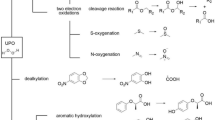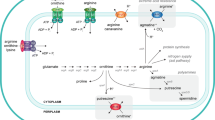Abstract
Cyclic dimeric GMP (c-di-GMP) has emerged as the nucleotide second messenger regulating both development and antibiotic production in high-GC, Gram-positive streptomycetes. Here, a diguanylate cyclase (DGC), CdgD, encoded by SCO5345 from the model strain Streptomyces coelicolor, was functionally identified and characterized to be involved in c-di-GMP synthesis through genetic and biochemical analysis. cdgD overexpression resulted in significantly reduced production of actinorhodin and undecylprodigiosin, as well as completely blocked sporulation or aerial mycelium formation on two different solid media. In the cdgD-overexpression strain, intracellular c-di-GMP levels were 13-27-fold higher than those in the wild-type strain. In vitro enzymatic assay demonstrated that CdgD acts as a DGC, which could efficiently catalyze the synthesis of c-di-GMP from two GTP molecules. Heterologous overproduction of cdgD in two industrial Streptomyces strains could similarly impair developmental transitions as well as antibiotic biosynthesis. Collectively, our results combined with previously reported data clearly demonstrated that c-di-GMP-mediated signalling pathway plays a central and universal role in the life cycle as well as secondary metabolism in streptomycetes.
Similar content being viewed by others
References
Al-Bassam, M.M., Haist, J., Neumann, S.A., Lindenberg, S., and Tschowri, N. (2018). Expression patterns, genomic conservation and input into developmental regulation of the GGDEF/EAL/HD-GYP domain proteins in Streptomyces. Front Microbiol 9, 2524.
Barka, E.A., Vatsa, P., Sanchez, L., Gaveau-Vaillant, N., Jacquard, C., Meier-Kolthoff, J.P., Klenk, H.P., Clément, C., Ouhdouch, Y., and van Wezel, G.P. (2016). Taxonomy, physiology, and natural products of actinobacteria. Microbiol Mol Biol Rev 80, 1–43.
Bentley, S.D., Chater, K.F., Cerdeño-Tárraga, A.M., Challis, G.L., Thomson, N.R., James, K.D., Harris, D.E., Quail, M.A., Kieser, H., Harper, D., et al. (2002). Complete genome sequence of the model actinomycete Streptomyces coelicolor A3(2). Nature 417, 141–147.
Bush, M.J., Tschowri, N., Schlimpert, S., Flärdh, K., and Buttner, M.J. (2015). c-di-GMP signalling and the regulation of developmental transitions in streptomycetes. Nat Rev Microbiol 13, 749–760.
Chng, C., Lum, A.M., Vroom, J.A., and Kao, C.M. (2008). A key developmental regulator controls the synthesis of the antibiotic erythromycin in Saccharopolyspora erythraea. Proc Natl Acad Sci USA 105, 11346–11351.
Christen, B., Christen, M., Paul, R., Schmid, F., Folcher, M., Jenoe, P., Meuwly, M., and Jenal, U. (2006). Allosteric control of cyclic di-GMP signaling. J Biol Chem 281, 32015–32024.
Den Hengst, C.D., Tran, N.T., Bibb, M.J., Chandra, G., Leskiw, B.K., and Buttner, M.J. (2010). Genes essential for morphological development and antibiotic production in Streptomyces coelicolor are targets of BldD during vegetative growth. Mol Microbiol 78, 361–379.
Elliot, M.A., Bibb, M.J., Buttner, M.J., and Leskiw, B.K. (2001). BldD is a direct regulator of key developmental genes in Streptomyces coelicolor A3(2). Mol Microbiol 40, 257–269.
Guan, F., Pan, Y., Li, J., and Liu, G. (2017). A GATA-type transcription factor AcAREB for nitrogen metabolism is involved in regulation of cephalosporin biosynthesis in Acremonium chrysogenum. Sci China Life Sci 60, 958–967.
Hackl, S., and Bechthold, A. (2015). The gene bldA, a regulator of morphological differentiation and antibiotic production in Streptomyces. Arch Pharm Chem Life Sci 348, 455–462.
Hengge, R. (2009). Principles of c-di-GMP signalling in bacteria. Nat Rev Microbiol 7, 263–273.
Higo, A., Hara, H., Horinouchi, S., and Ohnishi, Y. (2012). Genome-wide distribution of AdpA, a global regulator for secondary metabolism and morphological differentiation in Streptomyces, revealed the extent and complexity of the AdpA regulatory network. DNA Res 19, 259–274.
Higo, A., Horinouchi, S., and Ohnishi, Y. (2011). Strict regulation of morphological differentiation and secondary metabolism by a positive feedback loop between two global regulators AdpA and BldA in Streptomyces griseus. Mol Microbiol 81, 1607–1622.
Huang, H., Zheng, G., Jiang, W., Hu, H., and Lu, Y. (2015). One-step high-efficiency CRISPR/Cas9-mediated genome editing in Streptomyces. Acta Biochim Biophys Sin 47, 231–243.
Hull, T.D., Ryu, M.H., Sullivan, M.J., Johnson, R.C., Klena, N.T., Geiger, R.M., Gomelsky, M., and Bennett, J.A. (2012). Cyclic Di-GMP phosphodiesterases RmdA and RmdB are involved in regulating colony morphology and development in Streptomyces coelicolor. J Bacteriol 194, 4642–4651.
Jenal, U., Reinders, A., and Lori, C. (2017). Cyclic di-GMP: second messenger extraordinaire. Nat Rev Microbiol 15, 271–284.
Jones, S.E., and Elliot, M.A. (2018). ‘Exploring’ the regulation of Streptomyces growth and development. Curr Opin Microbiol 42, 25–30.
Kieser, T., Bibb, M.J., Butter, M.J., Chater, K.F., and Hopwood, D.A. (2000). Practical Streptomyces genetics. The John Innes Foundation, Norwich, United Kingdom.
Li, L., Wei, K., Zheng, G., Liu, X., Chen, S., Jiang, W., and Lu, Y. (2018). CRISPR-Cpf1-assisted multiplex genome editing and transcriptional repression in Streptomyces. Appl Environ Microbiol 84.
Li, L., Zhao, Y., Ruan, L., Yang, S., Ge, M., Jiang, W., and Lu, Y. (2015). A stepwise increase in pristinamycin II biosynthesis by Streptomyces pristinaespiralis through combinatorial metabolic engineering. Metab Eng 29, 12–25.
Liu, G., Chater, K.F., Chandra, G., Niu, G., and Tan, H. (2013). Molecular regulation of antibiotic biosynthesis in Streptomyces. Microbiol Mol Biol Rev 77, 112–143.
Liu, P., Zhu, H., Zheng, G., Jiang, W., and Lu, Y. (2017). Metabolic engineering of Streptomyces coelicolor for enhanced prodigiosins (RED) production. Sci China Life Sci 60, 948–957.
Li, Y., and Tan, H. (2017). Biosynthesis and molecular regulation of secondary metabolites in microorganisms. Sci China Life Sci 60, 935–938.
Meng, X., Wang, W., Xie, Z., Li, P., Li, Y., Guo, Z., Lu, Y., Yang, J., Guan, K., Lu, Z., et al. (2017). Neomycin biosynthesis is regulated positively by AfsA-g and NeoR in Streptomyces fradiae CGMCC 4.7387. Sci China Life Sci 60, 980–991.
Mouri, Y., Konishi, K., Fujita, A., Tezuka, T., and Ohnishi, Y. (2017). Regulation of sporangium formation by BldD in the rare actinomycete Actinoplanes missouriensis. J Bacteriol 199, e00840–16.
Nepal, K.K., and Wang, G. (2019). Streptomycetes: surrogate hosts for the genetic manipulation of biosynthetic gene clusters and production of natural products. Biotech Adv 37, 1–20.
Paul, R., Weiser, S., Amiot, N.C., Chan, C., Schirmer, T., Giese, B., and Jenal, U. (2004). Cell cycle-dependent dynamic localization of a bacterial response regulator with a novel di-guanylate cyclase output domain. Genes Dev 18, 715–727.
Rodríguez, H., Rico, S., Díaz, M., and Santamaría, R.I. (2013). Two-component systems in Streptomyces: key regulators of antibiotic complex pathways. Microb Cell Fact 12, 127.
Romling, U., Galperin, M.Y., and Gomelsky, M. (2013). Cyclic di-GMP: the first 25 years of a universal bacterial second messenger. Microbiol Mol Biol Rev 77, 1–52.
Ryjenkov, D.A., Tarutina, M., Moskvin, O.V., and Gomelsky, M. (2005). Cyclic diguanylate is a ubiquitous signaling molecule in bacteria: insights into biochemistry of the GGDEF protein domain. J Bacteriol 187, 1792–1798.
Schirmer, T., and Jenal, U. (2009). Structural and mechanistic determinants of c-di-GMP signalling. Nat Rev Microbiol 7, 724–735.
Schmidt, A.J., Ryjenkov, D.A., and Gomelsky, M. (2005). The ubiquitous protein domain EAL is a cyclic diguanylate-specific phosphodiesterase: enzymatically active and inactive EAL domains. J Bacteriol 187, 4774–4781.
Schumacher, M.A., Zeng, W., Findlay, K.C., Buttner, M.J., Brennan, R.G., and Tschowri, N. (2017). The Streptomyces master regulator BldD binds c-di-GMP sequentially to create a functional BldD2-(c-di-GMP)4 complex. Nucleic Acids Res 45, 6923–6933.
Tamayo, R., Pratt, J.T., and Camilli, A. (2007). Roles of cyclic diguanylate in the regulation of bacterial pathogenesis. Annu Rev Microbiol 61, 131–148.
Tran, N.T., Den Hengst, C.D., Gomez-Escribano, J.P., and Buttner, M.J. (2011). Identification and characterization of CdgB, a diguanylate cyclase involved in developmental processes in Streptomyces coelicolor. J Bacteriol 193, 3100–3108.
Tschowri, N. (2016). Cyclic dinucleotide-controlled regulatory pathways in Streptomyces species. J Bacteriol 198, 47–54.
Tschowri, N., Schumacher, M.A., Schlimpert, S., Chinnam, N.B., Findlay, K.C., Brennan, R.G., and Buttner, M.J. (2014). Tetrameric c-di-GMP mediates effective transcription factor dimerization to control Streptomyces development. Cell 158, 1136–1147.
van Wezel, G.P., and McDowall, K.J. (2011). The regulation of the secondary metabolism of Streptomyces: new links and experimental advances. Nat Prod Rep 28, 1311–1333.
Wang, R., Mast, Y., Wang, J., Zhang, W., Zhao, G., Wohlleben, W., Lu, Y., and Jiang, W. (2013). Identification of two-component system AfsQ1/Q2 regulon and its cross-regulation with GlnR in Streptomyces coelicolor. Mol Microbiol 87, 30–48.
Xu, Z., You, D., Tang, L.Y., Zhou, Y., and Ye, B.C. (2019). Metabolic engineering strategies based on secondary messengers (p)ppGpp and C-di-GMP to increase erythromycin yield in Saccharopolyspora erythraea. ACS Synth Biol 8, 332–345.
Yu, Z., Zhu, H., Dang, F., Zhang, W., Qin, Z., Yang, S., Tan, H., Lu, Y., and Jiang, W. (2012). Differential regulation of antibiotic biosynthesis by DraR-K, a novel two-component system in Streptomyces coelicolor. Mol Microbiol 85, 535–556.
Acknowledgements
This work was supported by the National Natural Science Foundation of China (31630003, 31570072 and 31770088), the Science and Technology Commission of Shanghai Municipality (18ZR1446700) and the National Science and Technology Major Project (2017ZX09101003-006-012). We are grateful to Yuanhong Shan, Wenli Hu and Wenzhi Zhou for LC-MS/MS analysis. We also thank Zhiping Zhang and Jiqin Li for field emission scanning electron microscopy (FESEM) analysis.
Author information
Authors and Affiliations
Corresponding authors
Additional information
Compliance and ethics The author(s) declare that they have no conflict of interest.
Supporting Information
Figure S1 Verification of the deletion of the six tested c-di-GMP-metabolizing enzyme genes in S. coelicolor by colony PCR.
Figure S2 Effects of the deletion of the six predicted c-di-GMP-metabolizing enzyme genes on morphological differentiation and antibiotic biosynthesis in S. coelicolor.
Figure S3 Time-course transcriptional analysis of the six predicted c-di-GMP-metabolizing genes in the wild-type S. coelicolor M145 on solid MS (A) and R2YE (B) media.
Figure S4 Effects of overexpression of the six predicted c-di-GMP-metabolizing enzyme genes on morphological differentiation and antibiotic biosynthesis in S. coelicolor on solid MS and R2YE media.
Figure S5 Intracellular c-di-GMP levels in the cdgC-overexpression mutant.
Figure S6 Amino acid sequence alignment of the GGDEF domains from eight identified or predicted c-di-GMP-metabolizing enzymes.
Figure S7 Some clues for the regulation of CdgD expression in S. coelicolor.
Table S1 Bacterial strains and plasmids used in this study
Table S2 Oligonucleotide sequences used in this study
The supporting information is available online at http://life.scichina.com and https://link.springer.com. The supporting materials are published as submitted, without typesetting or editing. The responsibility for scientific accuracy and content remains entirely with the authors.
Supplementary Materials
11427_2019_9549_MOESM1_ESM.doc
Overexpression of the diguanylate cyclase CdgD blocks developmental transitions and antibiotic biosynthesis in Streptomyces coelicolor
Rights and permissions
About this article
Cite this article
Liu, X., Zheng, G., Wang, G. et al. Overexpression of the diguanylate cyclase CdgD blocks developmental transitions and antibiotic biosynthesis in Streptomyces coelicolor. Sci. China Life Sci. 62, 1492–1505 (2019). https://doi.org/10.1007/s11427-019-9549-8
Received:
Accepted:
Published:
Issue Date:
DOI: https://doi.org/10.1007/s11427-019-9549-8




